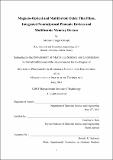| dc.contributor.advisor | Caroline A. Ross. | en_US |
| dc.contributor.author | Onbaş̧lı, Mehmet Cengiz | en_US |
| dc.contributor.other | Massachusetts Institute of Technology. Department of Materials Science and Engineering. | en_US |
| dc.date.accessioned | 2015-09-17T17:43:51Z | |
| dc.date.available | 2015-09-17T17:43:51Z | |
| dc.date.copyright | 2015 | en_US |
| dc.date.issued | 2015 | en_US |
| dc.identifier.uri | http://hdl.handle.net/1721.1/98579 | |
| dc.description | Thesis: Ph. D., Massachusetts Institute of Technology, Department of Materials Science and Engineering, 2015. | en_US |
| dc.description | This electronic version was submitted by the student author. The certified thesis is available in the Institute Archives and Special Collections. | en_US |
| dc.description | Cataloged from student-submitted PDF version of thesis. | en_US |
| dc.description | Includes bibliographical references. | en_US |
| dc.description.abstract | Complex oxide thin films offer unique functionalities which can potentially extend the utility of current storage, processing and optical isolator technologies. In this thesis, we present three categories of studies on complex oxide growth using pulsed laser deposition (PLD) and structural, magnetic, magneto-optical and ferroelectric characterization. We first focused on enhancing integrated magneto-optical isolator performance by improving the growth method of magneto-optical Ce1Y2Fe5O12 (Ce:YIG) films. The spectral and substrate orientation dependence of the magneto-optical figure of merit of epitaxial Ce: YIG on GGG substrates show very high magneto-optical figure of merit (379-400° dB-1 at [lambda] = 1550 nm for all substrate orientations). The thermal budgets of Ce: YIG growth on ShN4 (2 high temperature PLD steps and a rapid thermal anneal, RTA), silicon-on-insulator substrates (a high and a low temperature PLD step and a RTA) and optical resonator chips (one PLD step, one RTA, YIG seed layer from the top) were progressively reduced to achieve improved integrated optical isolators with low insertion loss of 7.4 ± 1.8 dB and an isolation ratio of 13.0 ± 2.2 dB. We demonstrated that the ferrimagnetic insulator YIG thin films (Y3Fe5O12) epitaxially grown on GGG substrates achieve ultralow Gilbert damping of spin waves ([alpha] = 2.2-7 x 10-4 ), which enable em-long in-plane propagation of spin waves. This demonstration enables researchers to fabricate near-dissipationless magnon-based logic computers. Finally, we present a substitutionally-doped perovksite, STCo30 (Sr Ti0.70 CO0.30 O3-[delta]) integrated on Si, STO (100), and on Nb:STO substrates. This perovskite oxide has been found to exhibit ferroelectricity and magnetism at room temperature. Experimental results on magnetism, ferroelectricity and structure were reproduced using density functional theory simulations. | en_US |
| dc.description.statementofresponsibility | by Mehmet Cengiz Onbaş̧lı. | en_US |
| dc.format.extent | 214 pages | en_US |
| dc.language.iso | eng | en_US |
| dc.publisher | Massachusetts Institute of Technology | en_US |
| dc.rights | M.I.T. theses are protected by copyright. They may be viewed from this source for any purpose, but reproduction or distribution in any format is prohibited without written permission. See provided URL for inquiries about permission. | en_US |
| dc.rights.uri | http://dspace.mit.edu/handle/1721.1/7582 | en_US |
| dc.subject | Materials Science and Engineering. | en_US |
| dc.title | Magneto-optical and multiferroic oxide thin films, integrated nonreciprocal photonic devices and multiferroic memory devices | en_US |
| dc.type | Thesis | en_US |
| dc.description.degree | Ph. D. | en_US |
| dc.contributor.department | Massachusetts Institute of Technology. Department of Materials Science and Engineering | |
| dc.identifier.oclc | 920882353 | en_US |

